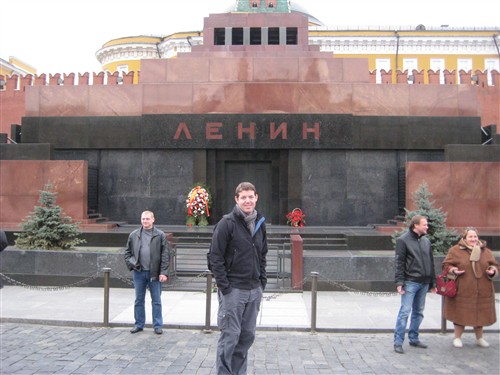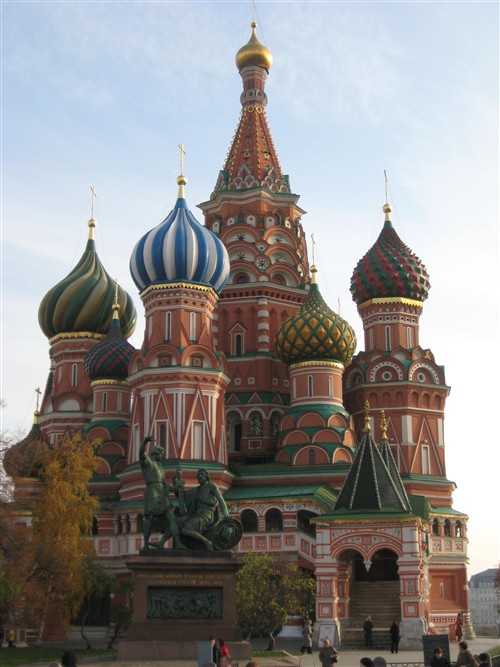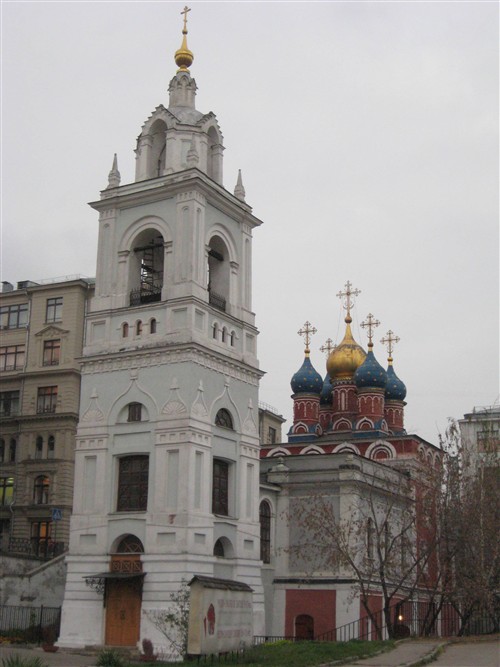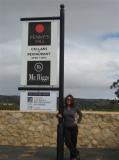Posted under Russia

On our second morning in Moscow, we walked back to Red Square for a more thorough exploration of its incredible buildings. First and foremost, we wanted to see Lenin’s body, which is on display inside a large granite mausoleum along the Kremlin wall. No cameras are allowed inside so we had to check our backpack in an adjacent cloakroom. As with most high-traffic areas in Russia, the movement of pedestrian traffic through the mausoleum was tightly controlled. Having passed through security, we followed the crowd along a sidewalk, passing grave markers of other Russian leaders, including Stalin, and meeting more uniformed security at every bend. Intimidation by numbers seems to be the strategy for Russian military and police. You would have to be mad to step out of line under the watchful eyes of so many armed men.
 Inside the mausoleum, we climbed a short, dark stairway into a dark room. In the center, Lenin’s illuminated corpse glowed like the moon inside a glass case. He wore a dark suit and his legs were covered in red velvet cloth. One hand was clenched in a fist but the other lay flat and I recall that his fingernails looked to be covered in yellowish fungus. We stared, dumbstruck, unable to look away. We were paralyzed with morbid fascination. One of the guards inside urged us forward and we started moving, albeit slowly, around the perimeter. It was a powerful experience. Lenin, who murdered over a million of his own people, abused and starved countless others to push through a social and political agenda that simply doesn’t work, is revered. After Lenin’s death, Stalin had Lenin’s brain removed so that he could study the “perfect Communist brain”.
Inside the mausoleum, we climbed a short, dark stairway into a dark room. In the center, Lenin’s illuminated corpse glowed like the moon inside a glass case. He wore a dark suit and his legs were covered in red velvet cloth. One hand was clenched in a fist but the other lay flat and I recall that his fingernails looked to be covered in yellowish fungus. We stared, dumbstruck, unable to look away. We were paralyzed with morbid fascination. One of the guards inside urged us forward and we started moving, albeit slowly, around the perimeter. It was a powerful experience. Lenin, who murdered over a million of his own people, abused and starved countless others to push through a social and political agenda that simply doesn’t work, is revered. After Lenin’s death, Stalin had Lenin’s brain removed so that he could study the “perfect Communist brain”.
Our minds aflutter with questions about the Communist-era, we made our next stop the State History Museum. We had visited the State Museum of Russian Political History in Saint Petersburg – a schizophrenic collection of artifacts lacking adequate English explanations and logical organization but fascinating nonetheless for those willing to sift through it. I was hoping that the State History Museum in Moscow would fill in the blanks. Russian history has proven to be fascinating but overwhelming, likely due to our lack of background knowledge, though we have scurried to read as much as possible in the past week to bring ourselves up to speed. I wanted to spend a little extra for the English audio guide so as not to miss any important details. We have used audio guides at museums and national tourist sites around the world and all have been rather modern contraptions but not in Russia. In Russia, you get a 1970s cassette tape recorder with two cassette tapes with the sound quality and lack of flexibility that come with such an outdated medium. It was yet another example of how little has been invested in the tourism industry, even in Russia’s flagship city.
The content of the State History Museum was different from what I expected. I wanted a better version of the Political History Museum but the State History Museum touched very little on politics. Instead, it focused on Russian culture dating as far back as the Stone Age. Save for a few school classes on field trip, we had the museum almost all to ourselves.
 Our final stop in Red Square was Saint Basil’s Cathedral. We had photographed its brilliant polychromatic domes from every angle but we had not yet been inside.
Our final stop in Red Square was Saint Basil’s Cathedral. We had photographed its brilliant polychromatic domes from every angle but we had not yet been inside.
Commissioned by Ivan the Great (a.k.a. Ivan the Terrible), to commemorate the defeat of the Tatars at Kazan, Saint Basil’s was intended from the start as more of a monument than a church. The story goes that, when the cathedral was completed in 1561, Ivan had his architects blinded to prevent a structure of equal magnificence from ever being built, though other sources dispute the story as little more than a colorful legend.
The interior of the cathedral was nothing like we’d expected. It was a maze of cavernous rooms covered in medieval wall paintings featuring flowers and herbs. Access from one level to another was via narrow, dimly-lit passages. The tiny individual chapels were ill-designed for any religious ceremony. The lack of functionality held true to the patron’s intent that St. Basil’s symbolize war victory rather than anything divine. We came out feeling utterly flabbergasted.
 We still had a long walk ahead of us and a list of interesting places to see so we quickly recovered and set out for the medieval neighborhood of Kitay Gorod. Located just southwest of Red Square, the 13th century neighborhood was the first to be established outside the protection of the Kremlin walls. We walked the streets toward a cluster of smaller but still impressive versions of Russia’s unique onion-domed churches. Not long into our foray, we began to notice a large number of luxury cars parked along the street and several black-clad muscle men lurking about in small groups, eyeing us suspiciously as we walked by. Our instincts told us that we had stumbled upon the Russian mafia and we felt an air of uneasiness but decided that our best course of action was to play the role of ignorant tourists – we were conveniently dressed for the part – snapping excessive photos of the churches without a backward glance. The moment passed without incident, of course, but we won’t soon forget that creepy feeling of brushing up against the mob.
We still had a long walk ahead of us and a list of interesting places to see so we quickly recovered and set out for the medieval neighborhood of Kitay Gorod. Located just southwest of Red Square, the 13th century neighborhood was the first to be established outside the protection of the Kremlin walls. We walked the streets toward a cluster of smaller but still impressive versions of Russia’s unique onion-domed churches. Not long into our foray, we began to notice a large number of luxury cars parked along the street and several black-clad muscle men lurking about in small groups, eyeing us suspiciously as we walked by. Our instincts told us that we had stumbled upon the Russian mafia and we felt an air of uneasiness but decided that our best course of action was to play the role of ignorant tourists – we were conveniently dressed for the part – snapping excessive photos of the churches without a backward glance. The moment passed without incident, of course, but we won’t soon forget that creepy feeling of brushing up against the mob.
 Taking the scenic route “home”, we passed by the Lubyanka Building, the former headquarters of the infamous KGB, which now houses its successor, the Federal Security Bureau; the Museum of Modern Art; and, most importantly, the world’s largest and busiest McDonald’s. With the capacity to accommodate up to 700 Hamburglars, the place was a zoo. After standing in a massive queue, we proceeded to suffer through the most excruciating ordering experience in our broad portfolio of international McDonald’s encounters. Out of 36 countries, Russia has posed the biggest language barrier. We did finally manage to communicate our order and get what we wanted but we left feeling defeated nonetheless.
Taking the scenic route “home”, we passed by the Lubyanka Building, the former headquarters of the infamous KGB, which now houses its successor, the Federal Security Bureau; the Museum of Modern Art; and, most importantly, the world’s largest and busiest McDonald’s. With the capacity to accommodate up to 700 Hamburglars, the place was a zoo. After standing in a massive queue, we proceeded to suffer through the most excruciating ordering experience in our broad portfolio of international McDonald’s encounters. Out of 36 countries, Russia has posed the biggest language barrier. We did finally manage to communicate our order and get what we wanted but we left feeling defeated nonetheless.
With our epic adventure quickly approaching its end, we are invigorated to finish strong. We are striving to keep our spirits high despite the daily infrastructure and language challenges and absorb every bit of this vibrant and dazzling final destination.
Comments Off on Red Square
